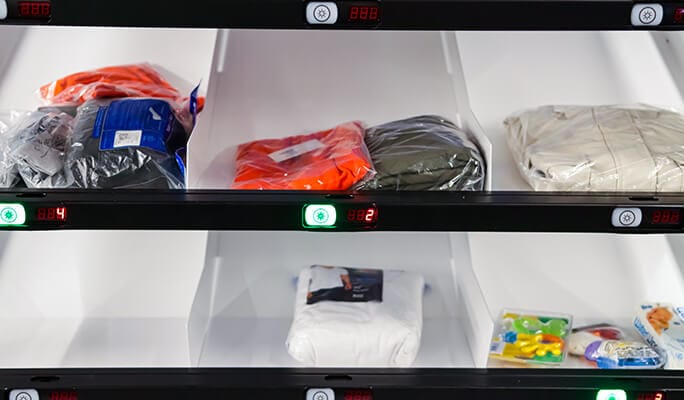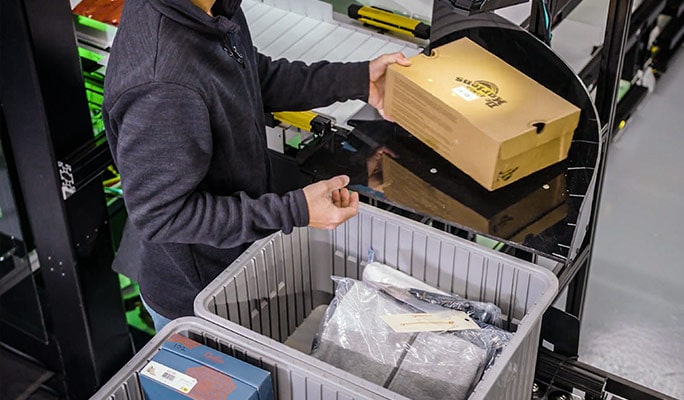Why Robot Hands Won’t Take Over the Warehouse Anytime Soon
Will robot hands take over the warehouse? Of course not! Vacuum …


When eCommerce pioneer and logistics expert Amazon announced free two-day shipping in 2005 (part of its new Amazon Prime subscription), it raised expectations for consumer delivery forever.
Not only could Amazon’s business model efficiently deliver an increasing variety of consumer items: from a single eyebrow pencil to a sturdily boxed mélange of different items. It also now could deliver things fast for “free” to an increasing number of customers.
The competitive bar for eCommerce was thus set. For both goliaths (the operations of fellow logistics experts like Walmart and major retailers like Nordstrom) and Davids (specialty retailers, grocery stores and pharmacy chains with fledgling eCommerce operations).
ECommerce companies and retailers have since been continually challenged to identify, pick, sort and pack items at the “each” level. And do it fast without externalizing their costs.
The obvious solution? Automation. Yet product fulfillment in warehouses — the most people-bound and gnarly part of the supply chain — has remained woefully under-automated. In fact, it’s estimated that 80% of retailers are still doing fulfillment mostly manually. And this in the face of continuing labor shortages across the board, persistent supply volatility, and ever-higher consumer expectations of the delivery experience, including multiple delivery options.
Robotic automation is an ideal solution, used by Amazon and other eCommerce and logistics leaders. However, the expertise, cost and complexity of deploying robotic solutions for eCommerce fulfillment has kept them beyond the reach of many retailers and eCommerce vendors.
Enter robotics as a service, or RaaS.
Robotics as a service is a business model that enables subscription-based acquisition of robotic automation solutions for fulfillment. This is similar to how companies today acquire the critical business software and computing capacity they need to run their business operations.
“Robotic solutions leverage software and artificial intelligence (AI) but also robotics hardware and supporting automation hardware to move and position totes and goods,” explains Roberto Michel, senior editor of Modern Materials Handling. “[However] if acquired through a traditional model as a CAPEX expense, this can make robotic automation seem out of reach to many companies with fulfillment operations.”
With robotics as a service (RaaS), businesses can adopt and deploy robotic automation solutions in a worry-free, flexible and timely manner. “Robotics as a service can not only help companies acquire robotic automation solutions without the upfront expense, but also when it comes to adapting the solution over time as needs change,” said Michel.
By comparison, a traditional robotic automation deployment in a warehouse can take about 18 months minimum, including acquiring equipment and software, assembling an engineering team, configuration/installation, AI training of robots, testing, and deployment. With RaaS, businesses can deploy faster and more incisively to match their business needs, capacity requirements, and unexpected demand changes. You can start small, automating high-priority areas first then expanding (or contracting), based on changing business needs.
The business benefits of RaaS are many.
ABI Research predicted that there will be more than 1.3 million RaaS deployments worldwide by 2026, with the largest installations in logistics, manufacturing, and hospitality. The supply chain industry is seeing growth in RaaS providers due to the growing market opportunity and sizable scenarios robotic automation can impact. As such, robotic automation is fast becoming the preferred approach for businesses to transform their supply chain systems into a competitive advantage.
Robotic automation can transform eCommerce fulfillment and supply chain deployment. For example, you can:
By giving you more control over the CAPEX and OPEX balance, RaaS can help you “smart size” your robotic automation investment to capture market share and business opportunity.
If you’re thinking about RaaS, make sure you do the following:
ECommerce businesses and retailers are facing a perfect storm today: persistent labor shortages, ever-higher customer expectations of product delivery, and inflexible fulfillment operations. Fortunately, robotic automation can address all three — and, with RaaS, it’s now available to more businesses.


There’s a proliferation of RaaS providers, helping you move forward fast. But picking the right partner is both critical and challenging.
In seeking the right RaaS partner, look for:
For example: Berkshire Grey’s pioneering RaaS solutions can help target many key areas for clients, such as packaging. Berkshire Grey uses AI and vision to empower robots to know how to pack cartons or bags in a fast, accurate and reliable way — even with high SKU variety and with zero “teaching” on each SKU.
With the global Robot as a Service market valued at US$ 14.5 billion in 2021 and expected to reach US$ 44 billion by 2028, the technology could be as catalytic as Amazon’s move to two-day shipping back in 2005.
But why wait any longer to find out?
Check out this recent webinar, Deploy Robotic Solutions with RaaS to Enable Worry-Free and Flexible Supply Chain Deployment, for more depth and discussion. Or call our experts today at 833-848-9900 with your use case.
Will robot hands take over the warehouse? Of course not! Vacuum …
In a recent webinar, “Unlock $20M Savings with Superior Efficiency: Robotic …
With a strong foundation of AI-driven robotics and a mission to …
Contact the BG Fulfillment Automation Sales Engineering Team to Learn How to:
Call +1 (833) 848-9900
or connect using our form.